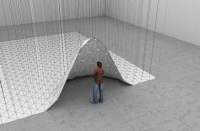SIMON MARXEN
in the bubble
source: talktothehanddk
I’ve just gratuated as bachelor in Digital Design with a theoretical paper about the interactive installation I’ve called – In The Bubble. The purpose of the project is to investigate the relationship between the concept of social interaction and my installation. In short the installation makes use of a responsive capacity to create privatized bobbles around its participants. This is made possible through: numerous computer-inspected pressure sensors that track the positions of the participants, metal pipes attached to electrical motors that shape the dynamic bubbles and a flexible rubber-material.
The flat shape of the form is held in place by the stiff metal pipes that furthermore are controlled in specific heights according to the position they represent in the form. The form of the bubble is by this method controlled by a computer keeping track of the many motors and the positions of the participants. Every metal pipe in the installation is connected to their own pressure-sensor in the floor giving the bubbles the ability to follow all participants’ moves. For safety, the ends of the metal pipes are constructed in a soft yielding material with a down-pointing moving-sensor. The computer is then forced to double-check for possible presence in the bubble before it returns to its’ point of origin.
The bubble seen from the top and a colored visualisation/chart of how much the strings must expand to meet the requirement of the structure.
Based on social interaction between the bystanders, the participants and a greater collective unit, the installation outlines the interplay between the private and the public and creates a portrayal of the everyday social interaction we as humans embark upon.
The primary theory used in the paper is based upon the work of sociologist Erwin Goffman and his thoughts on social behavior in public places. These theories constitute the foundation upon which the investigation is built supported by other pertinent sources. Visualizations and 3D renderings are used throughout the paper to help explain and discuss the interactive capabilities and limitations of the installation.
The analysis of the artwork shows that the overriding guideline – social interaction – is present both within and around the space of the interactive artwork. This, in turn, makes it possible to understand and discuss what the concept does for the actual experience and the space of interpretation.
The paper argues that social interaction exists not only among the participants, but has branched out into all the social events around the artwork. The social interaction is interpreted from three key spaces: the bystander’s social space, the participant’s social space and the social collective space. These key spaces constitute a social complexity that enhances the relationships between those present and gives an understanding of one’s own and others’ actions in space, while creating awareness of the inevitable confrontation with the surroundings. It is thus social interaction perceived and interpreted through both the private space, the confrontational meetings and a greater collective creation of meaning. Hence you are private in a social space.


